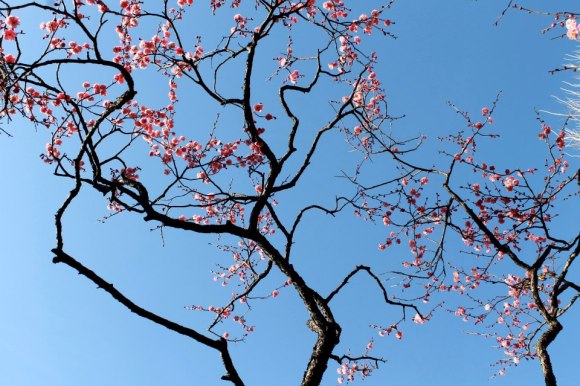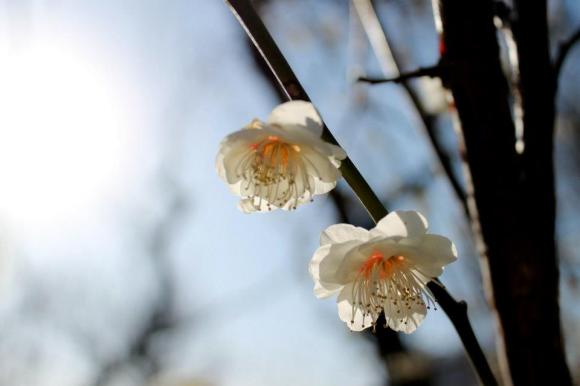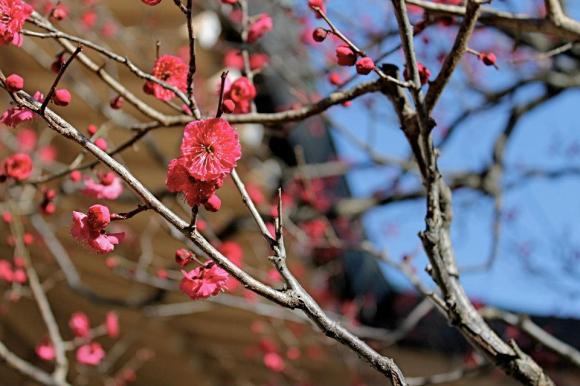
It’s cherry blossom time in Tokyo, which means that the plum blossom season is just coming to a close, and one of Tokyo’s most popular spots to see plum blossom, Umeno Park in Ome, has finished the season with a sad announcement: it is chopping down all 1,266 of its famous plum trees to prevent the spread of a disease called plum pox.
Plum blossom, or ume in Japanese, blooms just at the end of winter and come in shades of red, pink and white. Ume may not be quite as popular as the cherry blossom, since it’s usually too cold to hold parties under their blossom-laden branches, but they are beloved as harbingers of spring.
According to Ome’s agriculture and forestry division, the plum pox virus was first noticed in the city in 2009 and was spread by aphids and through grafting infected trees. Although it poses no danger to humans or animals, the virus causes discoloration of leaves and fruit and causes the fruit to fall from the tree before maturity. It can also spread to other stone fruit trees. There is no treatment available, so the only way to prevent the spread of the virus is to cut down infected plants.
Between 2009 and 2012, the city felled about 2,600 trees, but despite their efforts, the disease was found in 2010 to have spread to over a hundred trees in Umeno Park. Infected trees were cut down and removed, but the disease has continued to spread.
Last year, Japan’s Ministry of Agriculture, Forestry and Fisheries decreed that not only infected trees but those surrounding them should be felled, necessitating the destruction of some 500 trees in the park. Considering how many trees would have to be destroyed anyway, the city decided to fell all the remaining trees to be sure of eradicating the virus.
Ome has been called Japan’s number 1 city for plum blossoms, so the announcement was grave news for tourists and locals alike. The head of a local tourism cooperative was quoted as saying, “These trees are the symbol of our city. There aren’t words to express how sad this is, but we will move forward one step at a time to ensure they are resurrected.”
The city plans to replant the park once the area has been free of plum pox for three years.
Source: Yahoo! Japan News
Images: RocketNews24



 Japan’s weeping plum trees are so beautiful they’ll bring tears to your eyes【Photos】
Japan’s weeping plum trees are so beautiful they’ll bring tears to your eyes【Photos】 The Purple Lucky Bag from Village Vanguard is an extra-large waste of money
The Purple Lucky Bag from Village Vanguard is an extra-large waste of money Rakuten randomly offers 58 New Year’s osechi feasts in Japan, but did we get a star or a dud?
Rakuten randomly offers 58 New Year’s osechi feasts in Japan, but did we get a star or a dud? Japanese beef bowl chain Sukiya’s 2026 Smile Box lucky bag basically pays for itself
Japanese beef bowl chain Sukiya’s 2026 Smile Box lucky bag basically pays for itself Majority of Japanese mayors say foreign residents are essential but most see good and bad effects
Majority of Japanese mayors say foreign residents are essential but most see good and bad effects National Geographic names Yamagata Prefecture on its “Best of the World 2026” travel destinations
National Geographic names Yamagata Prefecture on its “Best of the World 2026” travel destinations Manga artist raises question online about false perspective in Ghibli film My Neighbor Totoro
Manga artist raises question online about false perspective in Ghibli film My Neighbor Totoro Don’t point that camera at me! Man arrested for taking “normal” picture on train
Don’t point that camera at me! Man arrested for taking “normal” picture on train We found possibly the quietest Japanese-style hotel in Tokyo’s bustling Shinjuku district
We found possibly the quietest Japanese-style hotel in Tokyo’s bustling Shinjuku district 7-Eleven now sells rice burgers in Japan, blurring the line between fast and convenience store food
7-Eleven now sells rice burgers in Japan, blurring the line between fast and convenience store food Starbucks Japan ready to get Year of the Horse started with adorable drinkware and plushies【Pics】
Starbucks Japan ready to get Year of the Horse started with adorable drinkware and plushies【Pics】 Hayao Miyazaki says Happy New Year to Studio Ghibli fans with new art for Year of the Horse
Hayao Miyazaki says Happy New Year to Studio Ghibli fans with new art for Year of the Horse Cup Noodle tries an authentic Jiro-style ramen, but something’s not quite right
Cup Noodle tries an authentic Jiro-style ramen, but something’s not quite right The best Starbucks Japan Frappuccinos we want to drink again in 2026
The best Starbucks Japan Frappuccinos we want to drink again in 2026 We revisited Sweets Paradise after a decade to see if Japan’s dessert buffet still delivers
We revisited Sweets Paradise after a decade to see if Japan’s dessert buffet still delivers That time Seiji called JASRAC to ask why he didn’t get paid royalties for his song being on TV
That time Seiji called JASRAC to ask why he didn’t get paid royalties for his song being on TV Japan’s oldest largetooth sawfish in captivity back on display in Mie Prefecture
Japan’s oldest largetooth sawfish in captivity back on display in Mie Prefecture Pizza Hut Japan’s hot lucky bags are perfect for a New Year’s pizza party
Pizza Hut Japan’s hot lucky bags are perfect for a New Year’s pizza party 7-Eleven Japan starts new temporary luggage storage service in over 300 branches
7-Eleven Japan starts new temporary luggage storage service in over 300 branches Disillusionment at Tsukiji’s tourist-target prices led us to a great ramen restaurant in Tokyo
Disillusionment at Tsukiji’s tourist-target prices led us to a great ramen restaurant in Tokyo Starbucks teams up with 166-year-old Kyoto doll maker for Year of the Horse decorations【Photos】
Starbucks teams up with 166-year-old Kyoto doll maker for Year of the Horse decorations【Photos】 Tokyo considering law requiring more trash cans following litter increase in heavily touristed area
Tokyo considering law requiring more trash cans following litter increase in heavily touristed area Tokyo’s Tsukiji sushi neighborhood asks tour groups to stay away for the rest of the month
Tokyo’s Tsukiji sushi neighborhood asks tour groups to stay away for the rest of the month Tokyo event lets you travel back in time, for free, to celebrate 100 years since Showa era start
Tokyo event lets you travel back in time, for free, to celebrate 100 years since Showa era start Japan may add Japanese language proficiency, lifestyle classes to permanent foreign resident requirements
Japan may add Japanese language proficiency, lifestyle classes to permanent foreign resident requirements Sanrio theme park in Japan announces plans to expand into a Sanrio resort
Sanrio theme park in Japan announces plans to expand into a Sanrio resort Stamina-destroying “Paralysis Noodles” are Tokyo’s newest over-the-top ramen innovation
Stamina-destroying “Paralysis Noodles” are Tokyo’s newest over-the-top ramen innovation Survey asks foreign tourists what bothered them in Japan, more than half gave same answer
Survey asks foreign tourists what bothered them in Japan, more than half gave same answer Japan’s human washing machines will go on sale to general public, demos to be held in Tokyo
Japan’s human washing machines will go on sale to general public, demos to be held in Tokyo Japan’s deadliest food claims more victims, but why do people keep eating it for New Year’s?
Japan’s deadliest food claims more victims, but why do people keep eating it for New Year’s? We deeply regret going into this tunnel on our walk in the mountains of Japan
We deeply regret going into this tunnel on our walk in the mountains of Japan Studio Ghibli releases Kodama forest spirits from Princess Mononoke to light up your home
Studio Ghibli releases Kodama forest spirits from Princess Mononoke to light up your home Major Japanese hotel chain says reservations via overseas booking sites may not be valid
Major Japanese hotel chain says reservations via overseas booking sites may not be valid Put sesame oil in your coffee? Japanese maker says it’s the best way to start your day【Taste test】
Put sesame oil in your coffee? Japanese maker says it’s the best way to start your day【Taste test】 No more using real katana for tourism activities, Japan’s National Police Agency says
No more using real katana for tourism activities, Japan’s National Police Agency says Starbucks Japan reveals new sakura drinkware collection, inspired by evening cherry blossoms
Starbucks Japan reveals new sakura drinkware collection, inspired by evening cherry blossoms Updated cherry blossom forecast shows extra-long sakura season for Japan this year
Updated cherry blossom forecast shows extra-long sakura season for Japan this year
Leave a Reply